21.7 points, 4.9 rebounds, 5.2 assists, 3.1 turnovers, 47% FG, 81% FT, 37% 3PT
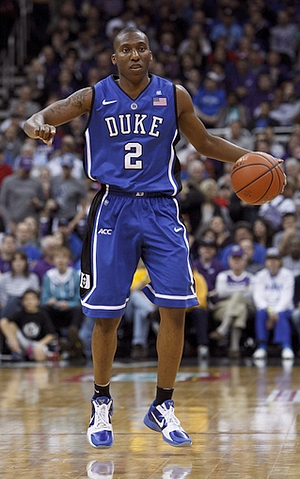
Derek Bodner
Developing into one of the most well-rounded guards in college basketball, Nolan Smith has answered some questions about his NBA future by filling in for Kyrie Irving on one of the nation's best teams, while leaving some still unanswered. Standing at 6'3, with a solid frame and good length, whether or not teams view Smith as capable of running the point for an extended period of time may determine how high he goes on draft night.
Having played the role of a combo guard in years past, Smith has shown an improved ability to run a team this year. He has edged into the tail end of the top 25 of NCAA point guard prospects in assists per-40 minutes pace adjusted, although his other point guard metrics still look underwhelming since he can be turnover prone at times. This is a problem largely stemming from the increased offensive burden he's asked to carry in the absence of Irving, a role which will likely decrease in the NBA.
As a passer, Smith does a good job of probing from the perimeter, recognizing cutters nicely, as well as finding spot-up shooters. While not great at getting into the lane, Smith does a good job of keeping his head up and spotting the open man when the defense rotates.
As mentioned, Smith has been asked to shoulder a heavier load in Duke's offense than in years past, and his diverse game has largely allowed him to succeed in this role, ranking 5th in scoring (per-40p) among NCAA players in our top 100 prospect rankings, in the 7th most efficient offense in college basketball.
Despite not having a tremendous first step, Smith does a good job of getting into the lane at the collegiate level. He has the ability to go either left or right in isolation sets, and does a good job of using hesitation and a change of direction to create space, showing great craftiness with the ball. Smith's likely an average athlete by NBA standards, limitations that show up a bit when finishing at the rim. He compensates by using his off hand well to shield defenders and showing good body control, with the ability to hit runners and floaters with some regularity. He has also done a better job of drawing contact and getting to the line than in years past, generally becoming a more effective scorer inside the arc this season.
As a shooter, Smith has shown improvement on catch and shoot opportunities, an area he was already strong at, and this is likely his offensive skill most ready to translate to the NBA. He has also been more effective on midrange shots, although he can be inconsistent with his shot overall. Still not picture perfect in form and not getting a ton of elevation, Smith may have more trouble getting his shot off when making the jump to NBA caliber defenders, although his shooting motion is short, creating a fairly quick release.
One area where he has shown considerable improvement is off pick and roll play, showing a little more ability to make shots coming off the pick and becoming more efficient on his midrange and pull-up jump shots. His timing and craftiness helps him quite a bit here, but continuing to make progress scoring off the pick and roll would help him facilitate the offense more, as he does show improving court vision as a passer in these sets.
Smith has good size to defend the point guard position in the NBA and has strong defensive fundamentals, while maintaining consistent effort. He does a good job of moving his feet laterally to close down driving lanes and closes out well on shooters, although he could still stand to improve fighting through the pick and roll. He also does a good job denying his man the ball when playing off the ball, but if asked to defend the shooting guard position with regularity he would be at a disadvantage in some situations.
Not a natural playmaker, Smith's ability to run an offense full time could be the key to whether or not he's seen as a legitimate starter down the line. Smith has a high basketball IQ and is a willing passer, and at the very least should be able to competently run an offense for stretches off the bench as a combo guard. The diversity of Smith's offensive game, even if he may not be dominant in any individual area, combined with his willingness and ability to defend the point should create a fairly limited floor and make Smith a reasonable bet to be a contributor at the next level, which will make him especially attractive to playoff teams picking in the second half of the first round.
John Jenkins, 6-4, Sophomore, Shooting Guard, Vanderbilt
19.4 points, 3.1 rebounds, 1.2 assists, 1.7 turnovers, 46% FG, 41% 3FG, 89% FT
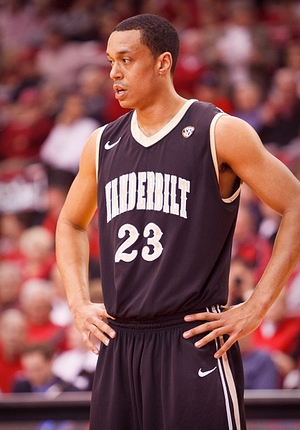
Kyle Nelson
After playing a role as a shooting specialist during his freshman season, Vanderbilt sophomore guard John Jenkins is averaging an efficient 19.4 points per game for the NCAA Tournament-bound Commodores.
Jenkins still underwhelms from a physical perspective at 6'4 with average length and an unimpressive frame. He is just an average athlete, as well, lacking elite quickness and explosiveness.
Jenkins has one of the best looking strokes in all of college basketball, showing fluid mechanics, a lightning quick release, and a consistent release point. He is effective spotting up, utilizing screens, and pulling up off of the dribble. Though his shot selection has been inconsistent at times this season, he should be able to translate his jump-shot fairly seamlessly to the NBA level. He's made 41% of his 8.4 attempts from beyond the arc per 40 minutes pace adjusted on the year.
Inside of the arc, Jenkins is still most effective pulling up off of the dribble, but has managed to become a more efficient finisher, converting 54% of his 2-point attempts, up from 45% last season. His mid-range game is developing nicely, as he has successfully incorporated a pull-up jump shot into his offensive arsenal. He is getting to the foul line quite a bit more as wellnearly twice as often per-minute--where he converts on an outstanding 89% of his free throw attempts.
Jenkins is still limited, however, by his below average shot-creating ability. In addition to predictably deferring to his left hand almost 70% of possessions, Jenkins continues to struggles off of the dribble due to his lack of advanced ball-handling skills. His lack of strength does not help here, but his first step does not look great either. He tends to dribble himself into bad situations without looking for his teammates.
Jenkins is just an average collegiate defender and will likely struggle at the next level in this area. He has trouble staying in front of most collegiate guards due to his poor lateral quickness and lack of strength. Furthermore, his weaknesses are amplified by inconsistent effort level, which he must improve if he wants to play a role in the NBA.
Jenkins has indicated that he plans on exploring his draft stock this summer and will consider entering the draft if he is a lock for the first round. While the NBA values elite shooters, Jenkins still has work to do in proving that he will not be a one dimensional player and a defensive liability. Players in this mold (Jason Kapono, Kyle Korver, etc) are not quite en vogue as much these days due to their shortcomings defensively. If Jenkins can lead finish out his sophomore season on a high note, he will have plenty of opportunities to show NBA decision makers in private workouts that he can do more than that at the next level, and attempt to boost his stock solidly into the first round.
Norris Cole, 6-2, Point Guard, Senior, Cleveland State
21.6 points, 6.0 rebounds, 5.3 assists, 2.2 steals, 2.7 turnovers, 44% FG, 36% 3PT, 85% FT
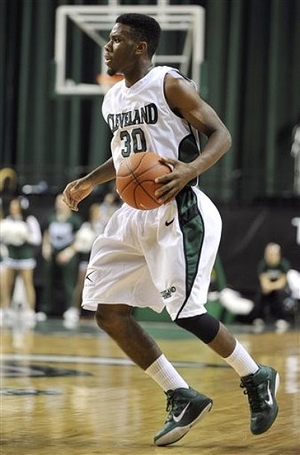
Joseph Treutlein
Steadily improving his game in each of his four years in college, Norris Cole developed into his team's clear-cut best player as a senior, but it appears his college career has come to an end after a loss in the Horizon League conference semifinals to rival Butler.
Looking at the way Cole has improved himself from his sophomore to senior season, what's remarkable is his dramatic increases in production across the board despite relatively static minutes. Increasing his points per game from 13.3 to 21.6 while more than doubling his assists without increased minutes is an impressive feat, and a testament to Cole's coachability and ability to excel in various roles.
The most improved aspect of Cole's game this season would have to be his point guard abilities and overall feel for the game, as he's developed into a complete point guard capable of making all the passes needed in the halfcourt and transition. Cole does most of his damage operating out of the pick-and-roll, where he sees the entire floor at all times, keeps his head up, and frequently makes tough passes out of double teams to open teammates.
Cole is equally dangerous pushing the ball in transition, where he likewise constantly has his head up and eyes scanning the court, while he shows extremely good control of the ball with both hands, even when operating at full speed. Cole relies mostly on subtle changes of speed and direction to get by his opponent, not having a flashy arsenal of advanced moves. He uses his craftiness to compensate for a just-solid first step, as he's not the most explosive player around, but he does have good top speed once he gets going.
In terms of his own scoring, Cole's increased his three-point shooting attempts and percentage all four seasons in college, to the point where he's shooting a respectable 36% on 4.0 attempts per game this year. While his numbers don't jump off the charts at this stage, there are multiple reasons to be optimistic about this area of his game looking forward, one of which is him interestingly being just as efficient off the dribble as he is spotting up. His form is consistent and he stays on balance very well when pulling up, something that helps him greatly in the pick-and-roll game when defenses sag.
Cole's continued learning curve and work ethic improving his shot are also encouraging looking forward, as is his impressive 85% free-throw percentage, something that could very well translate from longer distance as he gets stronger, puts in more practice, and sees less defensive attention on a more balanced team at the next level.
Attacking the basket, Cole is very potent off the dribble at the college level, using high screens especially well to gain separation and being quick to the basket once he gets a head of steam. His average size, narrow frame, lack of an elite first step and notable lack of explosiveness around the rim cause concern projecting to the next level, where he will likely need to develop more of a finesse game in the lane, as his floater and runner arsenal now is just solid at best. He also likely won't be able to rely on getting to the line 7.4 times per game, as the level of weakside defense he'll face will be on a totally different level athletically than what he sees in the Horizon conference.
Defensively, Cole has upped his efforts nicely this season, being the full package fundamentally in man-to-man defense, showing excellent focus level and positioning. He gets into a strong stance and is very aggressive getting into his man both on and off the ball, showing good hands and instincts. His lateral quickness is just good, not great, and he shows some problems fighting through more physical ball screens, but his effort level, team play, and coachability are attractive assets looking forward.
Looking forward, Cole's intangible profile is about as good as it gets, as he's shown an outstanding learning curve, great work ethic, and the flexibility to excel in multiple roles in his time in college, while he was also a high school quarterback and comes from a competitive family of coaches and athletes.
Despite his many strong-points, there are some concerns about him projecting to the next level, however, as he didn't play the toughest out-of-conference schedule, while Cleveland State has generally struggled against its tougher opponents. Not matching up against many NBA caliber guards or defenses may make it a bit more difficult for teams to evaluate him, as it's currently unknown how his skill-set will translate against better competition.
Cole's success at the next level should be most dependent on how his perimeter jumper continues to develop, but he already has a lot of traits teams look for in backup point guards, namely his prowess with the pick-and-roll, in transition, and his team-oriented, high energy style of play. A likely attendee of the Portsmouth Invitational Tournament, Cole could certainly help himself greatly there playing in front of every NBA team, as he could ease many of the doubts scouts have about the level of competition he played at in college.
Denzel Bowles, 6-10, Senior, Power Forward/Center, James Madison
17.8 points, 8.8 rebounds, 2.2 assists, 3.3 turnovers, 1.6 blocks, 58% FG, 71% FT
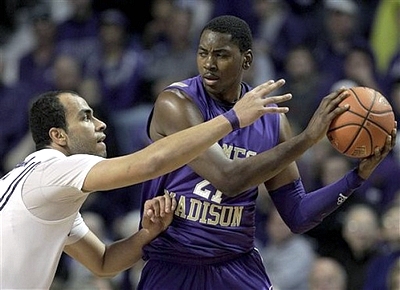
Walker Beeken
Denzel Bowles made a tremendous impact at James Madison during the 2009-2010 season following a transfer from Texas A&M, averaging over twenty points per game and establishing himself as a force in the paint in the Colonial Athletic Association. And while Bowles has had a similar senior season in 2010-2011 and showed many of the characteristics that make him an intriguing prospect, he hasn't made strides in the key areas where we noted that he struggled last season, most notably with his questionable motor, conditioning level and defensive ability.
As we mentioned before, Bowles has the size and talent to be able to produce at the mid-major level without always having to always give maximum effort. He's able to use his body to establish position in the basket area against smaller, less physically gifted players, and his outstanding hands, footwork, and touch help him finish and contribute to his impressive 58% shooting from the field.
Bowles plays like more of a traditional big man and seems to have a pretty good handle on the fact that he's most productive offensively if he's on the block or getting into the paint. Over 50% of his possessions have come in the post this season, and he's been pretty efficient, scoring .92 points per possession. This could be much better, however, if he didn't always insist on putting the ball on the floor after catching it in the post. We noted before the season that this led to him being very turnover-prone as a junior, and we saw much of the same when evaluating him this season.
He did show a bit more of his shooting ability in his senior season, attempting twice as many jumpers as he did as a junior, and connecting on a solid 48% of those attempts. His range doesn't look to extend past fifteen feet or so, but again, it's nice to see him knowing his limitations here and not trying to be somebody he's not. His ability to step outside of the paint and make a mid-range jumper should help him regardless of where he ends up playing professionally. Generally speaking, he seems to have a higher skill-level than you typically see from players his size, particularly in mid-major conferences.
On the defensive end, Bowles didn't show much this season to inspire much confidence in his potential to guard his position at the NBA level. His size makes him a presence in the paint in the CAA, but his fundamentals are poor, he doesn't move very well laterally, and his motor and toughness on this end are both inconsistent. Focusing more on this end and becoming a beast on the glass would really serve him well going forward, as he isn't talented enough offensively to overlook significant question marks about his defense.
Overall, Bowles senior season didn't show us much more than what we already knew about him. It's rare to find talented big men in his mold at the mid-major level, and he's a player who could still do quite a bit for his draft stock over the next few months as scouts get to see him matched up against stronger competition. He'll likely be at Portsmouth and have opportunities to showcase his game in workouts, and although his talent and skill level may impress some NBA decision-makers, perhaps the biggest thing for Bowles will be getting in shape and playing with consistent energy. Being only 21 years old, teams could hope that its only a matter of maturing and becoming more serious about his craft, something that they'll be able to learn more about during the pre-draft process.













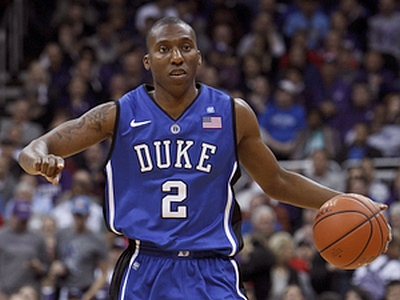




















Comments